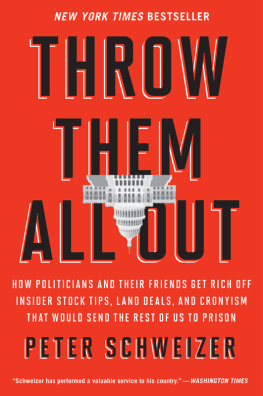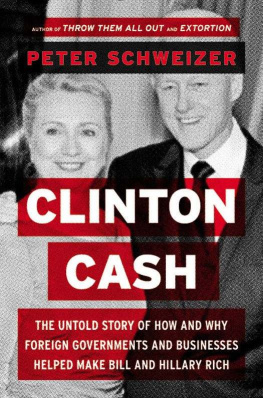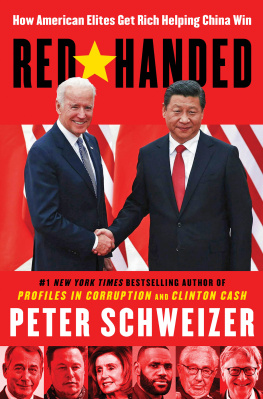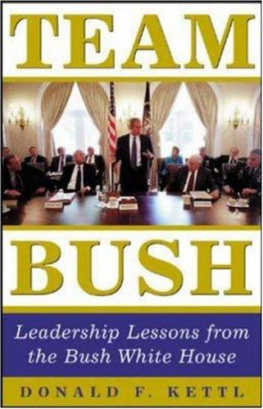BUSH BUCKS
How Public Service and Corporations
Helped Make Jeb Rich
Peter Schweizer
Contents
T he nonpartisan Government Accountability Institute (GAI) was founded on the fundamental belief that no political party is immune to cronyism, corruption, or governmental malfeasance.
For that reason, GAI has and will continue to follow the facts wherever they lead as we investigate politicians of all stripes who engage in self-enrichment using taxpayer dollars.
From Spencer Bachus (R-AL) to Nancy Pelosi (D-CA), Hillary Clinton (D-NY) to John Boehner (R-OH), GAIs investigatory findings on these and myriad other politicians have become the subject of featured stories on 60 Minutes , ABC News, Fox News, CNN, MSNBC, and others. Similarly, GAIs revelations have driven headlines in the New York Times , Washington Post , USA Today , Bloomberg, Wall Street Journal , and elsewhere.
The reason: facts transcend ideology and partisanship.
In that spirit, GAI presents Bush Bucks: How Public Service and Corporations Helped Make Jeb Rich.
GAI looks forward to releasing similar investigations in the months ahead as we strive to provide citizens with the transparency and accountability they deserve.
Stephen K. Bannon
Co-Founder and GAI Executive Chairman
T he intersection between money and politics often involves large sums of dollars flowing into American political campaigns, which, in turn, allow politicians, once elected, to disperse even larger sums of money through government programs that benefit their supporters and constituents.
Increasingly, public service can offer gateways to personal and family wealth, too. Sometimes, family members make the money when a public official serves in office. In other instances, public officials become wealthy after they leave office, thanks to the largesse of constituents a politician helped while in office.
Jeb Bush, throughout his early professional career, experienced a modicum of financial success in real estate. However, he accumulated a new magnitude of wealth in the years following his tenure as governor. How his public service relates to his new found wealth raises important questions about conflicts of interest and decisions he made while governor.
Jeb Bush graduated from the University of Texas magna cum laude after just two-and-a-half years. He married Columba young before plunging into the business world. He worked for the Texas Commerce Bank, setting up a branch office in Venezuela in 1977.
Codina offered the young Bush, then 27, a simple arrangement. He would provide the capital and South Florida contacts, and Jeb would help find tenants for commercial real estate developments. Jeb was not a real estate professional and was new to South Florida, but Codina clearly saw something in the young Bush.
As a partner in the Codina Bush Group, Jeb received a 40 percent stake.
Over the next decade in Miami, Jebs gross income rose dramatically. From 1981 to 1989, Jeb averaged $22,284 a year. By 1990, the second year of his fathers presidency, Jebs income jumped to $1.2 million. In 1991, it dipped to $482,636, before rising again in 1992 to $1.2 million.
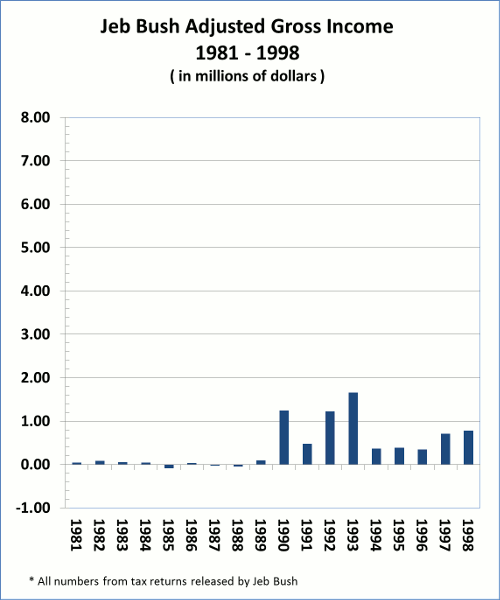
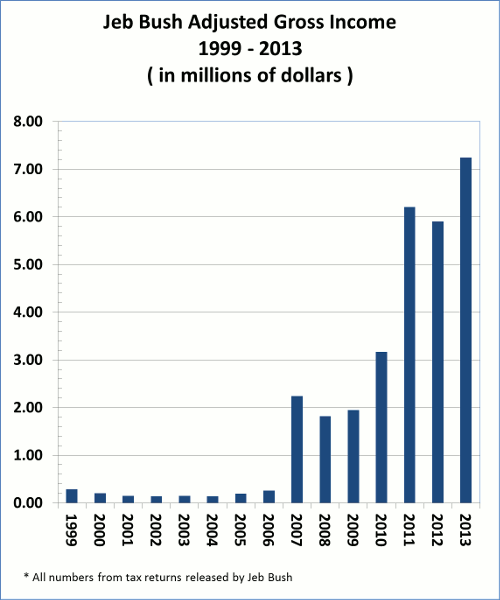
Codina Bushs many projects in South Florida included: the $400 million Beacon Center, a 205-acre tract in northwest Miami; Cocoplum, a 364-acre luxury waterfront community in Coral Gables, and the Deering Bay Yacht and Country Club, a residential development of 250 acres, and 8 tennis courts surrounded by an eighteen hole golf course designed by Arnold Palmer.
According to Jeb Bush, the firm started with three employees. By the time he left the firm, it was the largest commercial real estate company in South Florida with over 200 employees.
Jeb demonstrated a level of business acumen, but powerful relationships appear to have been extremely helpful. Take, for example, the case of one Miami office building.
In 1985, Jeb and Codina partnered with Florida bank executive J. Edward Houston to purchase an office building at 1390 Brickell Avenue in Miami, with Jeb again owning 20 percent of the venture. In addition to a $7 million mortgage, Houston took out a $4.6 million loan from Broward Federal Savings & Loan to finance the purchase.
For businessman Jeb Bush, the lure of public office was never far away. In the early 1980s, he contemplated a run for Congress from South Florida. He ultimately decided against it, concluding that it would place a financial strain on his young family. But by early 1993, after his father had lost his White House reelection bid the previous November, Jeb was ready to run for governor of Florida. He won the GOP nomination in a crowded field, but lost in the general election to Governor Lawton Chiles.
Jeb ran again in 1998 and this time won. His financial disclosure revealed a respectable, but not enormous, net worth of $2 million. Jeb went on to serve as governor for eight years. To his credit, Bush declined to take a state pension after leaving office, becoming the only living governor to do so.
T he serious questions arise with Jebs significant wealth accumulation after he left the governors mansion in January 2007. Over the next six years, Jeb collected a total income of $28.5 million. And his net worth rose dramatically, from $1.3 million to at least $19 million. Much of it came from four entities that greatly benefited from policy decisions he made while governor.
Was his public service connected with his wealth accumulation in the years that followed? The timing suggests they were. Were the actions Jeb took as governor influenced by the prospect of post-gubernatorial opportunities? That is impossible to say. But the connections between the firms that profited and the policies Bush undertook raise serious questions about conflicts of interest and the decisions he made during his gubernatorial tenure.
Intent is nearly impossible to discern. But we can follow the money and see whether the financial boom Jeb Bush experienced might be connected to his decisions as governor. Some of the money Jeb Bush made is untraceable. Since Jeb ran much of his income through his consulting firm Jeb Bush and Associates, Jebs financial disclosures reveal only his income from Jeb Bush and Associates, not necessarily all the clients that were paying him. In short, Jeb Bushs tax returns and financial disclosures leave large gaps in revealing who was actually paying him and how much in the years following his tenure as governor. For that reason, there are considerable sources of income that were not fully disclosed. But those we were able to identify raise serious questions about whether his decisions as governor were partially influenced by post-gubernatorial sources of income.
Most governors wield enormous power. Florida governors are no exception. They get to pick winners and losers and have enormous influence over state regulators and myriad government agencies that deal with issues such as land use, environmental regulations, granting contracts in everything from infrastructure to the management of state pension funds and determining where roads and other projects will be constructed. And of course the more power a public official has, the greater the possibility they can help or hurt individual companies. While members of the legislative branchU.S. Congress, Senate, or a state legislatorcan introduce or push legislation or make a phone call to a regulator, governors enjoy much richer opportunities to help or hurt individual businesses. The governor of a large state like Florida makes many decisions a week that can help a powerful ally or harm a political enemy. As former Virginia Governor and U.S. Senator George Allen once noted, I made more decisions in a half-day as Governor than you can make in a whole week in the Senate.


